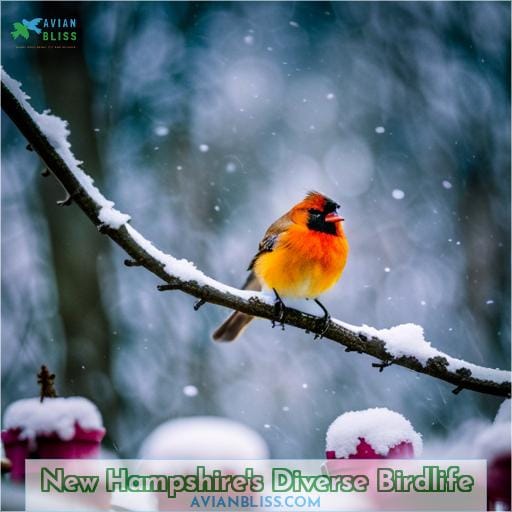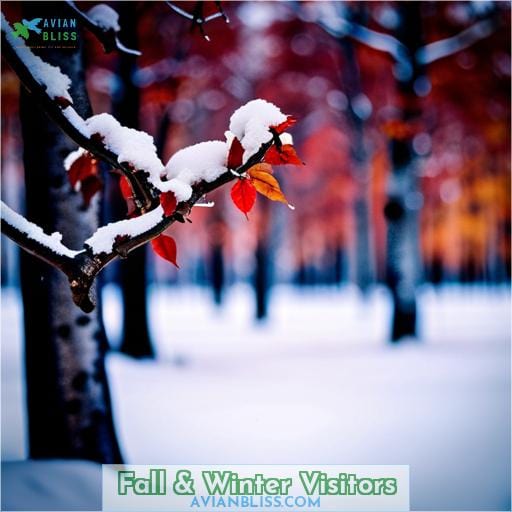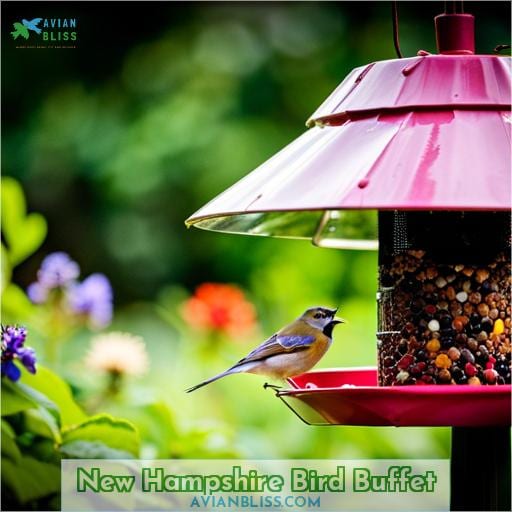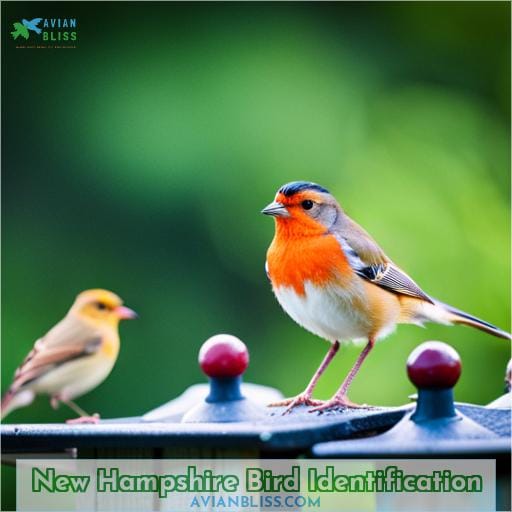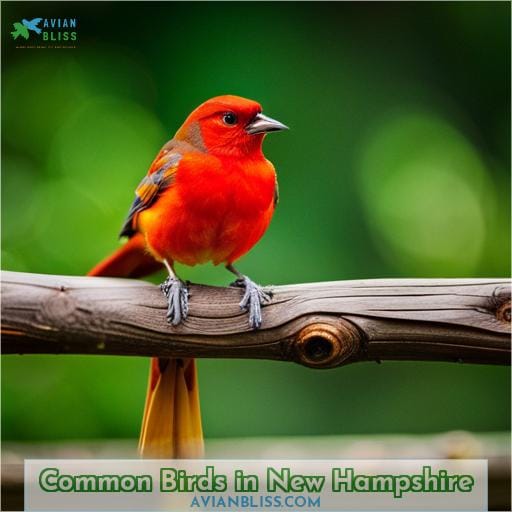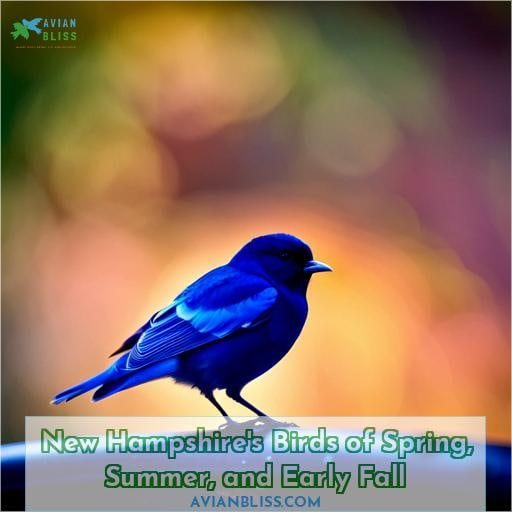This site is supported by our readers. We may earn a commission, at no cost to you, if you purchase through links.
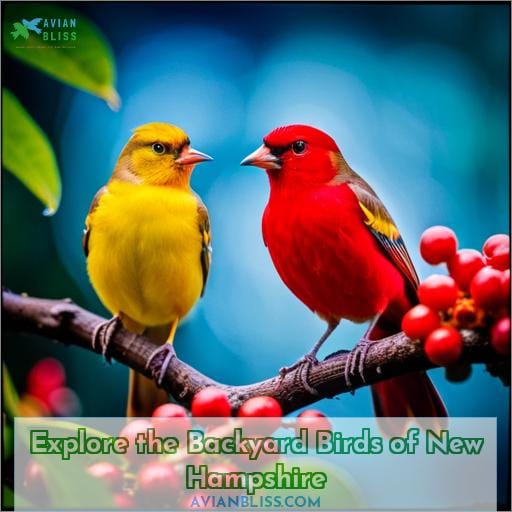 Are you ready to explore the incredible backyard birds of New Hampshire? With over 300 species recorded, the sky’s (literally) the limit when it comes to what feathered friends you may be able to spot!
Are you ready to explore the incredible backyard birds of New Hampshire? With over 300 species recorded, the sky’s (literally) the limit when it comes to what feathered friends you may be able to spot!
From tufted titmouse and mourning doves – year-round residents – to spring/summer visitors like Cedar Waxwings and Gray Catbirds, there is no shortage of variety. Fall/winter visitors such as Purple Finches and White-throated Sparrows also grace the skies.
Not only that, but other supporting cast members including Dark-eyed Juncos, Northern Cardinals, and Blue Jays are sure to excite any birding enthusiast. So buckle up for an amazing journey filled with tips on identification techniques for Eastern Phoebes or Red Bellied Woodpeckers.
Plus, gain insights into where exactly these birds can be found in abundance throughout each season! Get ready because New Hampshire’s backyard birds await your discovery!
Table Of Contents
- Key Takeaways
- New Hampshire’s Diverse Birdlife
- Common Year-round Resident Birds
- Spring/Summer & Early Fall Visitors
- Fall & Winter Visitors
- Supporting Cast: Other Backyard Birds
- New Hampshire Bird Buffet
- New Hampshire Bird Identification
- Common Birds in New Hampshire
- New Hampshire’s Year-round Resident Birds
- New Hampshire’s Birds of Spring, Summer, and Early Fall
- Conclusion
Key Takeaways
- New Hampshire has over 300 recorded bird species.
- There are year-round residents such as the Tufted Titmouse and Mourning Dove.
- Spring and summer visitors include Cedar Waxwings and Gray Catbirds.
- Fall and winter visitors include Purple Finches and White-throated Sparrows.
New Hampshire’s Diverse Birdlife
Exploring New Hampshire’s diverse regions like the White Mountains, Appalachian Highlands, and Eastern New England Uplands, you’ve recorded nearly 300 different bird species. Throughout the changing seasons, familiar year-round residents are encountered, returning spring and summer birds are anticipated, fall and winter visitors are welcomed, and occasionally a new species is spotted to add to your life list.
Regions of New Hampshire and Bird Diversity
Why not head up to the Appalachian Highlands and see if you can spot a Scarlet Tanager among the deciduous woods? New Hampshire’s diverse regions like the White Mountains, Eastern New England Uplands, and Appalachian Highlands host over 300 bird species.
From backyard feeders to remote birding hotspots, you’ll find year-round residents and seasonal migratory birds adapted to habitats like coniferous forests, wetlands, and shrublands. With a pair of binoculars in hand, visitors can experience the richness of birdlife across New Hampshire.
Year-round Residents, Spring/summer Visitors, Fall/winter Birds
Wow, your backyard has become a year-round bird paradise, with spring and summer warblers flitting through the foliage while winter finches flock to your feeders by the dozens! Every season presents new opportunities to observe New Hampshire’s diverse birdlife.
From acrobatic aerialists like the scarlet tanager to ground foragers such as the white-throated sparrow, an ever-changing cast of feathered friends passes through your backyard oasis. With a well-stocked feeding station and keen eyes, you’ll delight in the birds’ beauty and gain insight into their migration patterns and habitat preferences.
Common Year-round Resident Birds
As an avid birder, you’re undoubtedly familiar with several of New Hampshire’s most common backyard birds that reside here year-round. The Tufted Titmouse, Mourning Dove, Downy Woodpecker, American Goldfinch, and Black-capped Chickadee are fixtures at feeders and in the woods and fields of the Granite State no matter what time of year it is.
These birds brighten up backyards and woodlands with their colors and songs throughout all four seasons.
Tufted Titmouse
Look for this crest-sporting chap pecking seeds at your feeder. An acrobatic forager, flitting about deciduous woods near human homes. Listen for raspy peter-peter calls as the inquisitive titmouse investigates new food sources.
They nest in tree cavities, raising young on insects, nuts and seeds. Attract this blue-gray charmer to your yard with sunflower seeds, suet and peanuts. These backyard birds of New Hampshire bring color and activity as they faithfully visit feeders all year ’round.
Mourning Dove
With drooping wings and a forlorn coo, the crestfallen mourning dove perches by your stoop, its woeful visage belying the name you tenderly bestowed upon it long ago. Though melancholy in mien, this plump gray pigeon finds solace in your sheltering eaves.
Pecking at the seeds you spread, it seems grateful for your nurturing hand. As the dove departs, you feel your kindred spirits are linked by an unspoken bond.
Downy Woodpecker
Have you seen the black-masked white-faced woodpecker drilling holes in search of larvae while perched on the old oak tree’s trunk? The tiny, plucky Downy drills for insects concealed in wood crevices.
It nests in dead tree cavities, announcing its presence with repetitive drumming and soft calls. This small, sociable woodpecker frequents deciduous woodlands and backyard feeders filled with suet. Identify it by its diminutive size, black and white plumage with red crown patch.
You’ll delight in hearing the Downy’s tapping among the trees as it forages for beetle larvae, the sustenance of this charismatic New England bird.
American Goldfinch
Watch as the bright yellow males with black caps, known as American goldfinches, flock to your feeders in loose, fluid flocks, fluttering like splashes of sunshine come to life against the winter backdrop.
- They prefer weedy fields and open terrain with thistles and dandelions.
- They switch to a diet of tree buds, seeds, and fruit in winter.
- The males sing a series of sweet musical warbles and chirps.
Favoring open fields and gardens, these sociable finches descend on backyard feeders in buoyant, gregarious flocks. Their acrobatic flight and cheery disposition brighten even the dreariest winter day.
Black-capped Chickadee
The fluffy chickadee with its black cap and bib delights as it darts around backyard trees. Embodying curiosity, these tiny acrobats explore branches and peck away at seed cups. Their chick-a-dee-dee call brightens gray days, while high-pitched fee-bee songs signal it’s time to pair up and start a nest.
Though small, chickadees survive icy winters by packing on fat and huddling together to share warmth in tree cavities.
Spring/Summer & Early Fall Visitors
With your keen eye for detail and ear for song, you’ll be delighted to find some charming spring and summer visitors landing in your backyard. The flashy Cedar Waxwing, melodious Gray Catbird, vibrant Red-eyed Vireo, familiar American Robin, and stunning Scarlet Tanager are just a few of the avian gems you may encounter during their nesting sojourn or stopover on migration.
Cedar Waxwing
If a masked bandit slipped into your garden this spring just as the rhubarb was ripening, expect good luck to trickle through the coming summer.
- Fond of fruit, especially cherries and juniper berries, the cedar waxwing has a gregarious nature and often travels in large flocks.
- The breeding season for this mid-sized songbird runs from May to August.
With soft gray plumage and distinctive red wax-like wing tips, the cedar waxwing is a joy to observe feeding on berries and insects in your backyard. Its social tendencies and migratory patterns connect us to the rhythm of the seasons.
Gray Catbird
Spot the gray catbird’s slate-blue feathers and long tail in dense thickets while traipsing through edge habitats. Slipping unnoticed through tangled greenery, gray catbirds chatter and mimic other birds’ songs.
Curiosity may lure this secretive songster to poke its slate-gray head from the shadows when you pause near its preferred habitat along woodland edges. Catbirds primarily consume insects and fruits, pursuing ancient flyways each autumn to winter in the southern United States or Central America before returning north in the spring.
Red-eyed Vireo
You’ll often hear the buzzy song of the red-eyed vireo echoing through New Hampshire’s deciduous forests in spring and summer. The vireo’s olive green plumage blends in among the trembling leaves, but its repetitive song reveals its presence.
This tireless songster continuously sings while hopping from branch to branch, plucking insects hidden in the canopy. Red-eyed vireos prefer mature forests with tall trees for nesting and hunting caterpillars.
By late summer, they have departed for Central and South American wintering grounds until next spring’s migration north.
American Robin
Round spring you’ll see the red-breasted robin hopping on lawns and gathering worms, its cheerful song ringing through the air.
- Nest in low trees and shrubs, building sturdy nests from grass and mud.
- Feed on earthworms and insects; also enjoy berries later in the season.
- Males arrive first in spring, defending territories with spirited songs.
- Females arrive days later to select mate and nesting site.
- Most migrate south by November, though some overwinter farther north.
The familiar American robin is a welcome sign of spring and often the first migratory bird to return to backyards across New Hampshire.
Scarlet Tanager
The striking red bird could’ve been plucked from your backyard painting, bringing that scene to life among the deciduous woods and shrub cover.
A rare sighting in the backyard, this brilliant red migrant announces the return of warmer weather, feeding on insects high up in the treetops before continuing its breeding migration northward.
Admire this woodland dweller while you can.
| Appearance | Striking red plumage with black wings and tail, males are more colorful. |
|---|---|
| Size | Medium, about 7 inches long |
| Habitat | Deciduous woods and areas with dense shrub cover |
| Behavior | Forage for insects in treetops, sometimes catch prey mid-air. |
| Diet | Insects and fruit |
| Conservation | Vulnerable to habitat loss, climate change. |
Fall & Winter Visitors
Coming to your backyard this fall and winter are some welcome migratory visitors bringing delightful bursts of color and song. The purple finch’s raspberry back; the white-throated sparrow’s crisp markings; the showy plumage of the male rose-breasted grosbeak; the streaked song sparrow; and the bold stripes of the pine siskin are all ready to reward your bird-loving eyes.
You’ll want to take note as these special guests make their seasonal appearances.
Purple Finch
Looking resplendent with its raspberry-hued back, this medium-sized finch frequently visits coniferous woods in the colder months. Native to the northeast, this forest-dwelling seed eater migrates southward for winter yet still brightens backyards with splashes of red.
During fall and winter, nyjer feeders draw its attention, satisfying a craving for tiny seeds while conserving precious energy. Though bold and brightly colored, this elusive species usually keeps hidden, rewarding patience with fleeting sightings.
Favoring mature forests, preservation of wilderness havens sustains New Hampshire’s ephemeral purple finches.
White-throated Sparrow
Birdwatchers, here’s a great fall/winter visitor to spot in your New Hampshire backyard – the white-throated sparrow has a distinctive white throat and breast with brown streaks on its belly.
- It prefers forest edges and thickets. Listen for its sweet whistled song!
- This bird migrates south for the winter from Canada and the northern United States.
- It forages on the ground for seeds and insects.
- The white-throated sparrow helps control insect pests like beetles and caterpillars.
Rose-breasted Grosbeak
You’ll see their rose-red breasts flash by as male rose-breasted grosbeaks frequent orchards in fall and winter. The medium-sized grosbeaks prefer open woodland edges and gardens. Their migration takes them south for the winter.
Offer sunflower seeds, berries, and fruit at feeders to attract these beauties. Protecting forests helps conserve their breeding grounds up north.
| Description | Details |
|---|---|
| Size | Medium-sized |
| Migration | Breed in northeastern forests, winter in southern US and Mexico |
| Diet | Seeds, berries, fruit |
| Behavior | Gregarious, often in flocks |
| Conservation | Protect breeding habitat, offer food sources |
Song Sparrow
From dawn to dusk, you’ll spot this small, streaky sparrow hopping through brushy clearings and thickets:
- Tilting its head as it listens for insect prey
- Darting along the ground to forage for seeds
- Flitting up to perch briefly on a branch
- Singing sweet notes from atop a nearby shrub
The sparrow tilts its head, listening for insects to prey upon. It darts along the ground, foraging for seeds. Briefly perching on a branch, the little bird flits upwards. Atop a nearby shrub, it sings sweet notes.
Pine Siskin
See a streak of tan and yellow with dark lines flit among pine boughs when pinions of pine siskins beat a hasty retreat. The beady-eyed brown-streaked birds cling to conifer needles, feasting on seeds and berries.
These sociable finches twitter and chirp as they flock together, especially in winter when they migrate. Planting native trees like white pine attracts finicky pine siskins to your yard. Offer nyjer seed to entice the streaky little birds. Pine siskins bring joy when their cheery flocks descend on backyard feeders.
| Characteristic | Description |
|---|---|
| Size | Small, 4.5-5.5 inches |
| Colors | Tan, yellow, brown streaks |
| Behavior | Gregarious, flocking |
| Habitat | Coniferous woods |
| Diet | Seeds, berries |
Supporting Cast: Other Backyard Birds
Beyond New Hampshire’s seasonal migrants, several year-round backyard birds delight birdwatchers. The Dark-eyed Junco, Northern Cardinal, Blue Jay, White-breasted Nuthatch, and American Crow are easily recognized backyard favorites that you’ll commonly encounter at feeders or natural areas near home.
Dark-eyed Junco
Rather than sporting vivid markings, the dark-eyed junco has a modest grayish-brown coloring. Coniferous forests are the junco’s chosen winter home – they instinctively know fir tree sanctuaries offer security.
Juncos masterfully survive the cold season through their fat storage and communal flocking behaviors. Frequent visitors to backyard feeders, their diet of mixed seeds sustains the energy needed to endure the elements.
Though populations remain stable, juncos will always be treasured for their delicate beauty against pure white snow.
Northern Cardinal
You can clearly see the strikingly red-plumed northern cardinal frequenting your homestead as an alluring attraction.
- The northern cardinal prefers dense brush for cover, sunny forest edges, near feeders, often building nests in thickets or among branches.
- Strikingly colorful, with a red mask over their black faces, cardinals add a sweet song and splash of color to your backyard, often seen hopping along the ground searching for seeds or perched high and beautifully singing.
- The northern cardinal represents joy and hope, their return each spring brings renewed delight to birders and nature lovers.
Their devoted partners bring cheer all season long as you enjoy the pair visiting your yard regularly.
Blue Jay
With deep blue and white accenting plumage, blue jays frequent open woods and urban areas in their large size.
| Blue Jay Behavior | Blue Jay Habitat | Blue Jay Diet |
|---|---|---|
| Intelligent and curious | Open woods, edges of forests, parks, suburban neighborhoods | Omnivorous – eating insects, nuts, fruits, small vertebrates |
| Sometimes aggressive toward smaller birds | Range across eastern and central US into southern Canada | Opportunistic foragers |
| Mimicking hawks and other birds | Caching food items for later |
Interacting with blue jays reveals their spirited nature. Watch for these striking birds gracing your backyard, as they charm and delight you.
White-breasted Nuthatch
Under the ancient trees, the tiny nuthatch blends into the bark and taps away for insects. With its agile movements, the white-breasted nuthatch searches the trunks and branches for food. This energetic little bird probes into crevices, exploiting bark furrows for hidden morsels.
Its nasal yank-yank calls echo through the woods as it communicates with its kin. Small in size but busy in nature, the nuthatch plays a vital role in its forest home.
American Crow
Completely black, American Crows are a common sight in yards across New Hampshire! Their raucous caws echo as these intelligent birds gather in large flocks looking for food. Crows are very adaptable and can thrive in a variety of habitats, from forests to fields to urban areas.
Omnivorous crows eat insects, seeds, fruits and even small animals. Crows build large, messy nests high up in trees. Listen for their loud vocalizations as they fly around! American Crows are a fascinating bird to observe.
New Hampshire Bird Buffet
Draw hungry birds to your feeders with simple fare like suet, Nyjer thistle, sunflower seeds, jelly, and peanut butter to feast their eyes on New Hampshire’s feathered friends.
- Place feeders near cover for shy birds like nuthatches and wrens.
- Use tube feeders for thistle and smaller seeds for finches and chickadees.
- Offer large platform feeders with sunflower for cardinals, grosbeaks, and jays.
- Set out suet for woodpeckers, nuthatches, and chickadees.
- Try grape jelly in spring for orioles and peanut butter for starlings.
Seasonal offerings, diverse feeders, and keeping them clean will attract a delightful diversity of bird species to your backyard habitat. Exploring the habits and preferences of different birds keeps feeding engaging for both you and your avian visitors.
New Hampshire Bird Identification
If you look in New Hampshire backyards, a distinct, raspy fee-bee call could signal the arrival of an Eastern Phoebe. With underparts a pale yellow and white, this tyrant flycatcher frequently perches on a tree branch, darting out to catch insects in flight and returning to the same perch in its signature phoebe style.
A Red-bellied Woodpecker will also frequent backyard landscapes, calling attention with its zebra-striped black and white back and bright red cap. This woodpecker’s belly does not always appear red, contrary to its name; the red is often hidden as the bird clings to tree trunks chiseling away.
Eastern Phoebe
Spy that friendly Eastern Phoebe perching on your picket fence and belting out its classic fee-bee song!
The Eastern Phoebe is a small gray-olive bird with a white underside, round head, and short bill. It constantly wags its tail and darts out to catch insects. This flycatcher lives on farms, in suburbs, and in open woods, eating flies, beetles, wasps, and other insects.
It builds mud nests on man-made structures. The Eastern Phoebe migrates south for the winter, often returning to the exact same nesting site in spring.
Watch for its tail flicking and listen for its call to know when this welcomed insect eater has returned.
Red-bellied Woodpecker
Around the forest edge you see the red-bellied woodpecker pecking away.
- Striking black and white zebra-striped back
- Favors mature forests with dead trees for nesting
- Hollows out nests in soft deadwood
- Feeds on insects, fruits, nuts and berries
With its bright red cap, this busy woodpecker brings a splash of color as it hammers at the forest trees for insects.
Common Birds in New Hampshire
Avid birders rejoice! Backyard birding provides a front-row seat for the most sought-after species in New Hampshire. Throughout the seasons, spot resident favorites like the Black-capped Chickadee and American Goldfinch, along with fleeting spring and fall migrants such as the Cedar Waxwing and Purple Finch.
Most Common Backyard Birds Throughout the Year
Enjoy traditional year-round friends plus seasonal visitors when you view the most common backyard birds throughout the year in New Hampshire. The diversity keeps your feeders lively, with familiar faces and new discoveries arriving each season.
Even novice birdwatchers can identify backyard visitors with practice. Patience and persistence reveal nature’s avian treasures.
| Common Name | Scientific Name | Description |
|---|---|---|
| Black-capped Chickadee | Poecile atricapillus | Small-sized, gray and black bird frequenting deciduous and mixed forests year-round. Cheerful chick-a-dee-dee call. |
| Downy Woodpecker | Dryobates pubescens | Year-round resident that enjoys suet. Identify by white stripes on black wings and small size. Taps on trees. |
| Mourning Dove | Zenaida macroura | Pale brown plumage with dark spots on wings. Cooing call. Ground forager seen commonly. |
Keeping binoculars and field guides handy ensures you can identify familiar visitors and new discoveries. The parade of backyard birds delights the observant watcher throughout the year.
Most Common Backyard Birds in Winter
Look, the frosty winds bring such colorful gifts to grace the bare branches.
- Northern Cardinal
- Dark-eyed Junco
- Pine Siskin
As the chilly days descend, we await familiar feathered friends. Splashes of crimson, slate, and gold flit between frosted limbs. Lively birdsong trills through naked trees, reminding us that winter’s beauty lingers in nature’s small wonders.
Most Common Backyard Birds in Summer
You’d find American robins, red-eyed vireos, and scarlet tanagers filling New Hampshire woods in summer. Attract these colorful migrants to your backyard oasis by planting native flowering plants that provide nectar.
Mimic forest habitats since open lawns alone won’t entice most breeders. Identifying songs aids your search amid dense summer foliage. Patience and stillness unlock priceless encounters to admire striking plumage and capture close-up portraits with a camera.
New Hampshire’s Year-round Resident Birds
You can see the mule-headed downy woodpecker beating reliably on tree trunks all year round as New Hampshire’s familiar backyard drummers. These active little avians hop branch-to-branch inspecting bark crevices with bright eyes, probing deep to find insects with their awl-like bills.
Their diminutive size belying an extraordinary resilience, downies withstand cold winters while clinging vertically to trunks.
With a bit of patience, you may capture a photograph of them scaling a tree or perched on suet feeders.
To aid their survival, put up nesting boxes and plant native trees that furnish habitat and food sources. By supporting critical conservation initiatives and providing backyard buffers, we foster future generations of New Hampshire’s devoted resident downies.
New Hampshire’s Birds of Spring, Summer, and Early Fall
Let’s keep our binoculars peeled for spring and summer birds gracing New Hampshire, like the brilliant Scarlet Tanager lighting up our woods. The arrival of migratory birds transforms our forests and backyards into vibrant scenes filled with birdsong.
Watch for the slate-gray Catbird skulking through tangled thickets as it mimics calls of other birds. Scan treetops to spot the olive-green Red-eyed Vireo singing its repetitive song. The American Robin’s cheery caroling echoes through woods as it forages on lawns.
Grab your binoculars and camera to observe these beauties up close – their breeding plumage and behaviors are fascinating! Use a field guide to identify species and mark off your checklist.
Before you know it, fall will arrive and many of these feathered friends will continue their extraordinary journeys south.
Conclusion
Discovering the backyard birds of New Hampshire is a captivating experience for birdwatchers and nature enthusiasts. With the diverse regions of the White Mountains, Eastern New England Uplands, Appalachian Highlands and more, an approximate 300 bird species have been recorded in New Hampshire.
From the small-sized Tufted Titmouse and Downy Woodpecker to the striking Scarlet Tanager and Northern Cardinal, many common year-round residents, spring/summer visitors, and fall/winter birds can be seen.
For the ultimate birding experience, New Hampshire has numerous hotspots, such as the Northern, Eastern, Southern, Western, and Central areas, as well as a variety of bird buffets including suet, nyjer thistle, black oil sunflower, grape jelly and crunchy peanut butter.
So, take a step outside and explore the world of backyard birds in New Hampshire.

